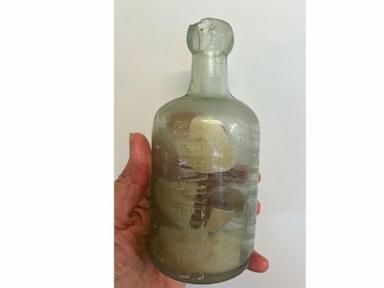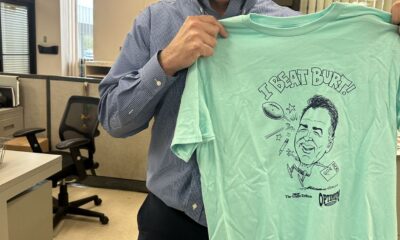World
Messages from WWI Soldiers Discovered in Bottle After 107 Years

Messages in a bottle, penned by two Australian soldiers during their journey to the battlefields of World War I, have recently been unearthed on the coast of Australia more than a century later. The discovery occurred on October 9, 2023, when the Brown family stumbled upon the Schweppes bottle at Wharton Beach, near Esperance in Western Australia.
Deb Brown, along with her husband Peter and daughter Felicity, found the bottle while engaging in their routine beach cleanup, which often involves clearing litter from the shore. Deb noted, “We do a lot of cleaning up on our beaches and so would never go past a piece of rubbish. So this little bottle was lying there waiting to be picked up.” The bottle contained letters written in pencil by Privates Malcolm Neville, 27, and William Harley, 37, dated August 15, 1916.
Their troop ship, the HMAT A70 Ballarat, had departed from Adelaide on August 12, 1916, as part of a long voyage to reinforce the 48th Australian Infantry Battalion on the Western Front. Tragically, Neville was killed in action a year later, while Harley survived the war, enduring two wounds but ultimately succumbing to cancer in 1934 that his family attributes to gas exposure during combat.
In their letters, Neville addressed his mother, Robertina Neville, requesting the finder to deliver his message to her at Wilkawatt, South Australia, now a ghost town. Harley, whose mother had passed by the time he wrote, expressed his hope that the finder would keep his note. He wrote, “may the finder be as well as we are at present.”
Neville’s letter shared a glimpse of life aboard the ship, stating, “I’m having a real good time, food is real good so far, with the exception of one meal which we buried at sea.” He added, “We are as happy as Larry,” using a phrase that reflects an upbeat Australian sentiment. Harley referred to their location as “Somewhere in the Bight,” referencing the Great Australian Bight, a vast bay stretching from east of Adelaide to Esperance.
Deb Brown suspects that the bottle had been buried in the sand for much of its century-long existence. Recent erosion along Wharton Beach likely exposed it, allowing for the remarkable discovery. The letters, although wet, remained legible, which enabled Deb to notify the soldiers’ families about the find.
The bottle is described as being in “pristine condition,” with no barnacle growth, leading Deb to conclude that it had not been at sea for an extended period. She remarked that had it been exposed to the elements for long, the paper would have disintegrated, making the writing unreadable.
Harley’s granddaughter, Ann Turner, expressed her family’s astonishment at the discovery, stating, “We just can’t believe it. It really does feel like a miracle and we do very much feel like our grandfather has reached out for us from the grave.”
For Neville’s great nephew, Herbie Neville, this find has united family members around the “unbelievable” discovery. He reflected on his great uncle’s spirit, stating, “It sounds as though he was pretty happy to go to the war. It’s just so sad what happened. It’s so sad that he lost his life.” With pride, he added, “Wow. What a man he was.”
This extraordinary find not only sheds light on the personal experiences of soldiers during World War I but also serves as a poignant reminder of the lives lost and the stories that remain tethered to history.
-

 Sports2 weeks ago
Sports2 weeks agoSteve Kerr Supports Jonathan Kuminga After Ejection in Preseason Game
-

 Politics2 weeks ago
Politics2 weeks agoDallin H. Oaks Assumes Leadership of Latter-day Saints Church
-

 Business2 weeks ago
Business2 weeks agoTyler Technologies Set to Reveal Q3 2025 Earnings on October 22
-

 Science2 weeks ago
Science2 weeks agoChicago’s Viral ‘Rat Hole’ Likely Created by Squirrel, Study Reveals
-

 Lifestyle2 weeks ago
Lifestyle2 weeks agoKelsea Ballerini Launches ‘Burn the Baggage’ Candle with Ranger Station
-

 Lifestyle2 weeks ago
Lifestyle2 weeks agoDua Lipa Celebrates Passing GCSE Spanish During World Tour
-

 Entertainment2 weeks ago
Entertainment2 weeks agoZoe Saldana Advocates for James Cameron’s Avatar Documentary
-

 Health2 weeks ago
Health2 weeks agoRichard Feldman Urges Ban on Menthol in Cigarettes and Vapes
-

 Health2 weeks ago
Health2 weeks agoCommunity Unites for Seventh Annual Mental Health Awareness Walk
-

 World2 weeks ago
World2 weeks agoD’Angelo, Iconic R&B Singer, Dies at 51 After Cancer Battle
-

 Business2 weeks ago
Business2 weeks agoMLB Qualifying Offer Jumps to $22.02 Million for 2024
-

 Sports2 weeks ago
Sports2 weeks agoPatriots Dominate Picks as Raiders Fall in Season Opener








